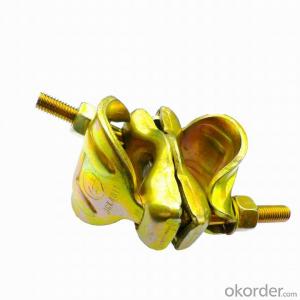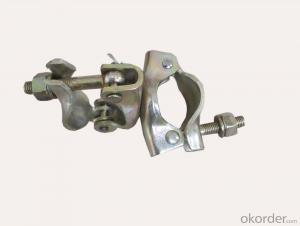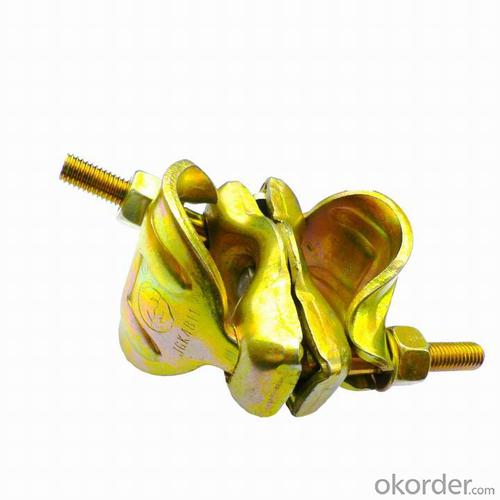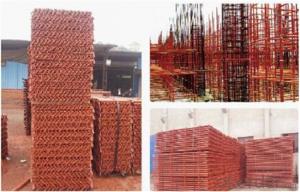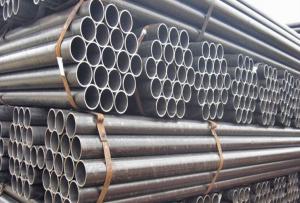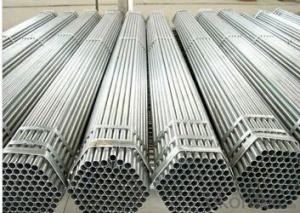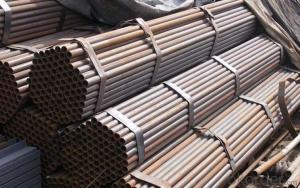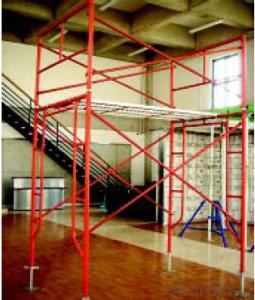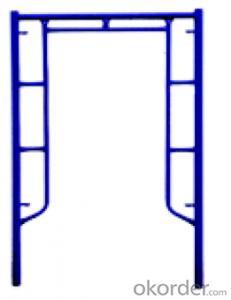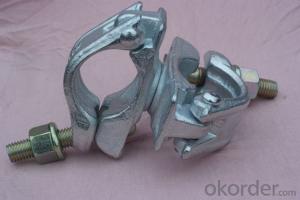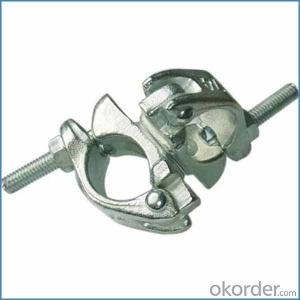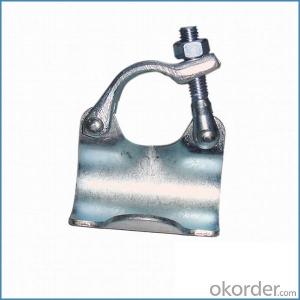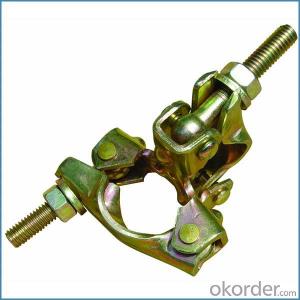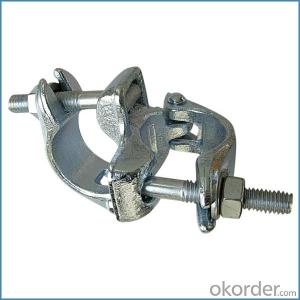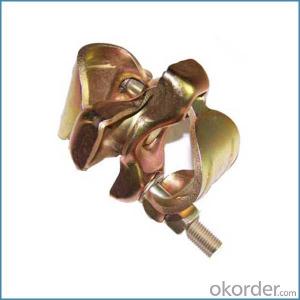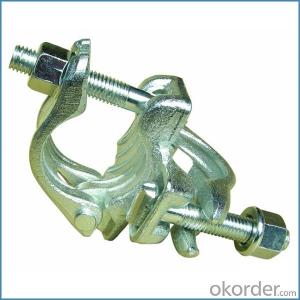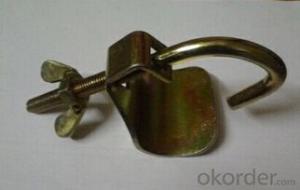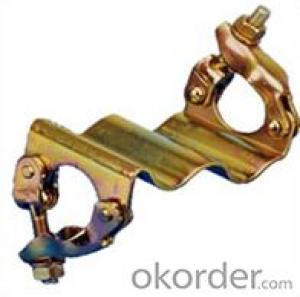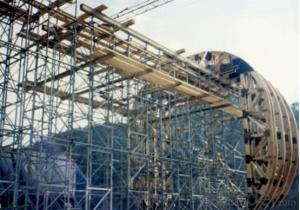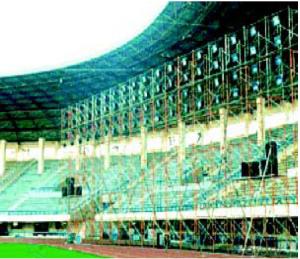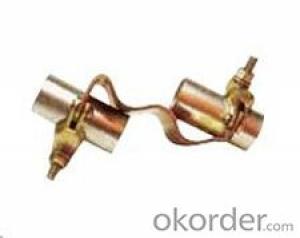Scaffold Toe Board Clamp british German Forged Type
- Loading Port:
- Tianjin
- Payment Terms:
- TT OR LC
- Min Order Qty:
- 1000 kg
- Supply Capability:
- 100000 kg/month
OKorder Service Pledge
OKorder Financial Service
You Might Also Like
Scaffold Toe Board Clamp british German Forged Type
Description
1.The scaffolding coupler is always used to connect the steel pipe as scaffolding system.
2.The often used coupler is swivel coupler and righ angle coupler .
3.We can provide types of scaffolding coupler according to your requirement.
4.Couoler can fix the 48.3mm scaffolding steel pipe tightly and make the whole scaffolding system more steadily.
Feature
(1)Excellent Anti-Breaking—Cold Pressed Steel
(2)Outstanding Resistance Deformation
(3)Strong Anti-Dropping Ability
Photo
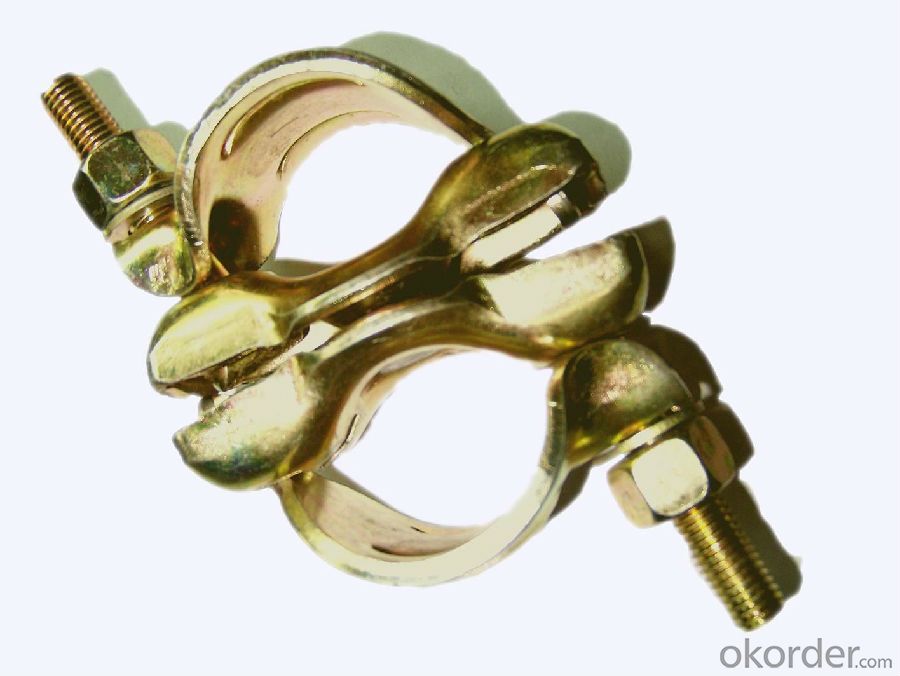
Parameter
| Material | Q235,345steel |
| Size | 48.3mm*48.3mm |
| Surface finish | Galvanized |
| Weight | 1.1kg around |
| Standard | BS1139,EN74 |
| Package | 25pcs/bag,steel pallet |
| Manufacture | As per customer requirement |
| Market | Africa, South America, the Middle East and Asia |
FAQ
Q: Are you a factory or trading company?
We are a state-owned corporation in China,dealing with various kinds of building materials.We have our holding subsidiaries.
Q: Where is your factory located? How can I visit there?
Our factory is located all around China.
Q: Can I get some samples?
Sample is free, customer only pay freight for the first time.
Q: Delivery?
10-30days. (5-15 containers)
Any question,feel free to contact us.
- Q: Can steel tube couplers be used with non-standard scaffolding tubing?
- No, steel tube couplers are designed to be used specifically with standard scaffolding tubing. Using them with non-standard tubing may compromise the safety and stability of the scaffolding structure. It is important to always use compatible components to ensure proper functionality and structural integrity.
- Q: On the high-profile model erection of fastener-type steel pipe and door scaffolding mix, combined with work and professional knowledge, not less than 2000 words of the paper
- Norms written very clearly, seriously look to know.
- Q: Can steel tube couplers be used for both temporary and long-term scaffolding installations?
- Yes, steel tube couplers can be used for both temporary and long-term scaffolding installations. They are durable and provide a strong connection between the scaffold tubes, making them suitable for various scaffolding projects regardless of their duration.
- Q: How do steel tube couplers ensure the structural integrity and stability of scaffolding systems?
- Ensuring the structural integrity and stability of the entire structure, steel tube couplers are an indispensable element of scaffolding systems. Their primary function is to securely connect steel tubes, forming a scaffold framework that is strong and dependable. A key way in which steel tube couplers ensure structural integrity is by establishing a firm and inflexible connection between individual steel tubes. These couplers are specifically designed to tightly grip the tubes, preventing any movement or slippage. This tight connection guarantees that the scaffold remains stable and does not sway or collapse under the weight of workers and materials. Additionally, the design of steel tube couplers allows for a wide range of angles and connections, enabling scaffolding systems to be adaptable to various shapes and sizes. This flexibility permits the scaffolding to be tailored to the specific requirements of different construction projects. By utilizing couplers to create precise connections between tubes, the scaffold can be constructed accurately and securely. Furthermore, steel tube couplers enhance the overall strength of the scaffolding system by securely connecting multiple tubes, evenly distributing the load across the structure. This distribution of weight reduces the strain on individual tubes and prevents the formation of weak points. Consequently, the scaffold can support heavy loads and withstand external forces such as wind and vibrations, ensuring the safety of workers and the stability of the structure. Moreover, steel tube couplers are designed to withstand harsh environmental conditions and resist corrosion, ensuring the longevity and reliability of the connections between tubes, even in challenging working environments. By maintaining the integrity of the connections, the couplers contribute to the long-term stability and safety of the scaffolding system. In conclusion, steel tube couplers play a vital role in ensuring the structural integrity and stability of scaffolding systems. By securely connecting steel tubes, they establish a rigid framework capable of withstanding heavy loads, adapting to different shapes, and resisting external forces. The durability and reliability of these couplers contribute to the overall safety and efficiency of scaffolding systems in construction projects.
- Q: Can steel tube couplers be used in scaffolding projects with uneven or sloped surfaces?
- Steel tube couplers, which can be utilized in scaffolding ventures involving uneven or sloped surfaces, are engineered to establish reliable and robust connections between steel tubes. These couplers possess exceptional adaptability, enabling them to conform to diverse angles and surfaces, even those that are uneven or sloped. With the incorporation of adjustable couplers, the scaffolding can effortlessly be modified to suit the precise demands of the undertaking, guaranteeing both stability and safety. Ensuring the proper construction of the scaffolding and securely tightening the couplers are vital in maintaining the structural integrity of the scaffolding.
- Q: How do steel tube couplers contribute to the overall versatility of a scaffolding structure?
- Steel tube couplers play a crucial role in enhancing the overall versatility of a scaffolding structure. These couplers are used to connect different steel tubes together, creating a strong and stable framework that can withstand heavy loads and provide a safe working environment. One of the primary ways in which steel tube couplers contribute to versatility is through their ability to create various configurations and shapes. Couplers allow scaffolding tubes to be connected at different angles, enabling the construction of scaffolding structures in complex and challenging environments. This adaptability allows workers to reach different heights, work around obstacles, and access hard-to-reach areas, making scaffolding structures incredibly versatile. Furthermore, steel tube couplers are easily adjustable and reusable. Unlike traditional fixed scaffolding systems, couplers can be easily detached and repositioned, allowing for quick and efficient adjustments on the job site. This flexibility is particularly valuable in situations where the scaffolding structure needs to be modified or extended during the construction process. Additionally, steel tube couplers provide a high degree of stability and strength, ensuring the safety of workers and the integrity of the scaffolding structure. The tight connection created by these couplers eliminates any wobbling or movement in the scaffolding, making it a reliable platform for workers to carry out their tasks. This stability is especially important when working at great heights or in challenging weather conditions. Moreover, steel tube couplers are compatible with a wide range of scaffolding accessories and components. This compatibility allows for the integration of additional features such as guardrails, walkways, and stairs, further enhancing the versatility and functionality of the scaffolding structure. These accessories can be easily attached or detached using the couplers, providing flexibility to adapt the scaffolding system to specific project requirements. In conclusion, steel tube couplers contribute significantly to the overall versatility of a scaffolding structure. Their ability to create various configurations, easy adjustability, stability, and compatibility with other scaffolding components make them an essential element in constructing safe, efficient, and adaptable scaffolding systems.
- Q: Are steel tube couplers suitable for scaffolding projects with limited assembly time?
- Steel tube couplers are indeed appropriate for scaffolding projects that have a limited amount of time for assembly. These couplers can be installed rapidly and effortlessly, enabling the construction of scaffolding structures to be done efficiently and quickly. They establish a dependable and steady connection between steel tubes, guaranteeing the safety and stability of the scaffolding system. Moreover, steel tube couplers are robust and resilient, capable of enduring substantial loads and harsh weather conditions, which makes them an ideal option for scaffolding projects that necessitate a swift assembly process. All in all, steel tube couplers prove to be a trustworthy and effective choice for scaffolding projects that have a restricted amount of time available for assembly.
- Q: What are the specific safety features of steel tube couplers?
- Steel tube couplers have several specific safety features that make them a reliable and secure option for joining steel tubes. Firstly, steel tube couplers are designed to ensure a strong and stable connection between two steel tubes. They have a high load capacity, allowing them to withstand heavy loads and provide structural integrity. This helps to prevent any potential failure or collapse of the structure. Additionally, steel tube couplers are usually made from high-quality steel, which adds to their durability and strength. They are often treated with corrosion-resistant coatings, such as galvanized or epoxy coatings, to protect them from rust and other environmental factors. This ensures that the couplers maintain their structural integrity over time, even in harsh conditions. Another important safety feature of steel tube couplers is their ease of installation. They are typically quick and easy to assemble, requiring minimal tools or specialized equipment. This reduces the risk of accidents or errors during installation, ensuring a safe and reliable connection. Furthermore, steel tube couplers are designed to provide a secure connection that prevents any movement or rotation between the joined tubes. This reduces the risk of disconnection or misalignment, which could compromise the stability and safety of the structure. Some couplers also have additional features, such as locking mechanisms or set screws, to further enhance the secure connection. Overall, the specific safety features of steel tube couplers, including their load capacity, durability, corrosion resistance, ease of installation, and secure connection, make them a trusted choice for various construction applications.
- Q: Can steel tube couplers be used in scaffolding projects with uneven terrain?
- Yes, steel tube couplers can be used in scaffolding projects with uneven terrain. Steel tube couplers are versatile and can be adjusted to fit various angles and levels, making them suitable for scaffolding on uneven terrain. These couplers are designed to connect steel tubes securely, providing stability and strength to the scaffold structure. Additionally, the adjustable nature of steel tube couplers allows for easy leveling and alignment of scaffolding components on uneven ground, ensuring a safe and secure work platform.
- Q: Can steel tube couplers be used in scaffolding projects with complex structures?
- Scaffolding projects with intricate designs can utilize steel tube couplers. These couplers possess versatility, enabling the connection of tubes at different angles and facilitating the creation of personalized scaffolding structures. Their design ensures robust and secure connections, guaranteeing the stability and safety of the scaffolding system. Moreover, steel tube couplers exhibit durability and can withstand significant loads, making them suitable for supporting complex scaffolding structures. Nonetheless, it is crucial to install and use these couplers correctly, adhering to industry standards and guidelines to preserve the integrity and safety of the scaffolding system.
Send your message to us
Scaffold Toe Board Clamp british German Forged Type
- Loading Port:
- Tianjin
- Payment Terms:
- TT OR LC
- Min Order Qty:
- 1000 kg
- Supply Capability:
- 100000 kg/month
OKorder Service Pledge
OKorder Financial Service
Similar products
Hot products
Hot Searches
